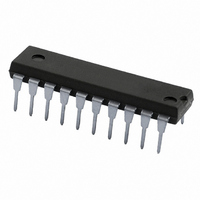PCF8584P,112 NXP Semiconductors, PCF8584P,112 Datasheet - Page 37

PCF8584P,112
Manufacturer Part Number
PCF8584P,112
Description
IC CTRL PARALLEL/I2C BUS 20-DIP
Manufacturer
NXP Semiconductors
Datasheet
1.PCF8584P112.pdf
(40 pages)
Specifications of PCF8584P,112
Package / Case
20-DIP (0.300", 7.62mm)
Controller Type
Parallel Bus to I²C Bus Controller
Interface
Parallel
Voltage - Supply
4.5 V ~ 5.5 V
Current - Supply
1.5mA
Operating Temperature
-40°C ~ 85°C
Mounting Type
Through Hole
Maximum Operating Temperature
+ 85 C
Minimum Operating Temperature
- 40 C
Mounting Style
Through Hole
Operating Supply Voltage
4.5 V to 5.5 V
Lead Free Status / RoHS Status
Lead free / RoHS Compliant
Lead Free Status / RoHS Status
Lead free / RoHS Compliant, Lead free / RoHS Compliant
Other names
568-3532-5
935069300112
PCF8584PN
935069300112
PCF8584PN
Philips Semiconductors
16 SOLDERING
16.1
There is no soldering method that is ideal for all IC
packages. Wave soldering is often preferred when
through-hole and surface mounted components are mixed
on one printed-circuit board. However, wave soldering is
not always suitable for surface mounted ICs, or for
printed-circuits with high population densities. In these
situations reflow soldering is often used.
This text gives a very brief insight to a complex technology.
A more in-depth account of soldering ICs can be found in
our “IC Package Databook” (order code 9398 652 90011).
16.2
16.2.1
The maximum permissible temperature of the solder is
260 C; solder at this temperature must not be in contact
with the joint for more than 5 seconds. The total contact
time of successive solder waves must not exceed
5 seconds.
The device may be mounted up to the seating plane, but
the temperature of the plastic body must not exceed the
specified maximum storage temperature (T
printed-circuit board has been pre-heated, forced cooling
may be necessary immediately after soldering to keep the
temperature within the permissible limit.
16.2.2
Apply a low voltage soldering iron (less than 24 V) to the
lead(s) of the package, below the seating plane or not
more than 2 mm above it. If the temperature of the
soldering iron bit is less than 300 C it may remain in
contact for up to 10 seconds. If the bit temperature is
between 300 and 400 C, contact may be up to 5 seconds.
16.3
16.3.1
Reflow soldering techniques are suitable for all SO
packages.
Reflow soldering requires solder paste (a suspension of
fine solder particles, flux and binding agent) to be applied
to the printed-circuit board by screen printing, stencilling or
pressure-syringe dispensing before package placement.
1997 Oct 21
I
2
C-bus controller
Introduction
DIP
SO
S
R
R
OLDERING BY DIPPING OR BY WAVE
EPAIRING SOLDERED JOINTS
EFLOW SOLDERING
stg max
). If the
37
Several techniques exist for reflowing; for example,
thermal conduction by heated belt. Dwell times vary
between 50 and 300 seconds depending on heating
method. Typical reflow temperatures range from
215 to 250 C.
Preheating is necessary to dry the paste and evaporate
the binding agent. Preheating duration: 45 minutes at
45 C.
16.3.2
Wave soldering techniques can be used for all SO
packages if the following conditions are observed:
During placement and before soldering, the package must
be fixed with a droplet of adhesive. The adhesive can be
applied by screen printing, pin transfer or syringe
dispensing. The package can be soldered after the
adhesive is cured.
Maximum permissible solder temperature is 260 C, and
maximum duration of package immersion in solder is
10 seconds, if cooled to less than 150 C within
6 seconds. Typical dwell time is 4 seconds at 250 C.
A mildly-activated flux will eliminate the need for removal
of corrosive residues in most applications.
16.3.3
Fix the component by first soldering two diagonally-
opposite end leads. Use only a low voltage soldering iron
(less than 24 V) applied to the flat part of the lead. Contact
time must be limited to 10 seconds at up to 300 C. When
using a dedicated tool, all other leads can be soldered in
one operation within 2 to 5 seconds between
270 and 320 C.
A double-wave (a turbulent wave with high upward
pressure followed by a smooth laminar wave) soldering
technique should be used.
The longitudinal axis of the package footprint must be
parallel to the solder flow.
The package footprint must incorporate solder thieves at
the downstream end.
W
R
EPAIRING SOLDERED JOINTS
AVE SOLDERING
Product specification
PCF8584















